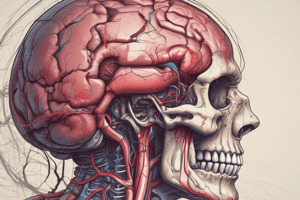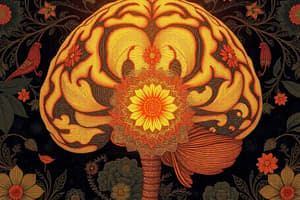Podcast
Questions and Answers
Which of the following is a clinical manifestation of COPD?
Which of the following is a clinical manifestation of COPD?
- Edema
- Mental deterioration
- Liver enlargement
- Chronic cough (correct)
What is the primary cause of emphysema in COPD patients?
What is the primary cause of emphysema in COPD patients?
- Excessive mucus production
- Pulmonary hypertension
- Inflammation of the bronchi
- Loss of lung elasticity due to alveoli hyperinflation (correct)
Which risk factor is considered a modifiable risk factor for COPD?
Which risk factor is considered a modifiable risk factor for COPD?
- Age
- Immunosuppression
- Conditions with mucus
- Smoking (correct)
What causes portal hypertension in cirrhosis?
What causes portal hypertension in cirrhosis?
What is a common complication of cirrhosis related to ammonia metabolism?
What is a common complication of cirrhosis related to ammonia metabolism?
Which diagnostic test is used specifically to diagnose COPD?
Which diagnostic test is used specifically to diagnose COPD?
What leads to the production of excessive mucus in chronic bronchitis?
What leads to the production of excessive mucus in chronic bronchitis?
What is a consequence of scar tissue replacing healthy liver tissue in cirrhosis?
What is a consequence of scar tissue replacing healthy liver tissue in cirrhosis?
What is a common clinical manifestation of esophageal varices?
What is a common clinical manifestation of esophageal varices?
Which of the following best describes the pathology of Crohn’s disease?
Which of the following best describes the pathology of Crohn’s disease?
What dietary recommendation is often provided for patients with diverticulosis?
What dietary recommendation is often provided for patients with diverticulosis?
Which of the following symptoms is typically associated with diverticulitis?
Which of the following symptoms is typically associated with diverticulitis?
What effect does Crohn’s disease have on the intestines over time?
What effect does Crohn’s disease have on the intestines over time?
Which symptom is NOT typically associated with myasthenia gravis?
Which symptom is NOT typically associated with myasthenia gravis?
What is the primary cause of esophageal varices in patients with cirrhosis?
What is the primary cause of esophageal varices in patients with cirrhosis?
What is a potential complication if esophageal varices rupture?
What is a potential complication if esophageal varices rupture?
What is primarily responsible for the obstruction of blood flow in peripheral arterial disease (PAD)?
What is primarily responsible for the obstruction of blood flow in peripheral arterial disease (PAD)?
Which clinical manifestation is considered a priority for monitoring in patients with peripheral arterial disease?
Which clinical manifestation is considered a priority for monitoring in patients with peripheral arterial disease?
Which of the following best describes Virchow's triad related to deep vein thrombosis (DVT)?
Which of the following best describes Virchow's triad related to deep vein thrombosis (DVT)?
Which symptom is a result of left-sided heart failure?
Which symptom is a result of left-sided heart failure?
For a patient diagnosed with heart failure, which dietary recommendation is most appropriate?
For a patient diagnosed with heart failure, which dietary recommendation is most appropriate?
What is a common clinical manifestation of deep vein thrombosis (DVT)?
What is a common clinical manifestation of deep vein thrombosis (DVT)?
Which diagnostic test is not typically used for assessing heart failure?
Which diagnostic test is not typically used for assessing heart failure?
Which classification indicates significant limitation and distress during physical activity in heart failure patients?
Which classification indicates significant limitation and distress during physical activity in heart failure patients?
What is a common clinical manifestation of ulcerative colitis?
What is a common clinical manifestation of ulcerative colitis?
What is the primary underlying cause of cholecystitis?
What is the primary underlying cause of cholecystitis?
Which bacteria is most commonly associated with cholecystitis?
Which bacteria is most commonly associated with cholecystitis?
Which of the following is a systemic manifestation of rheumatoid arthritis?
Which of the following is a systemic manifestation of rheumatoid arthritis?
What pathological process occurs in the joints of patients with rheumatoid arthritis?
What pathological process occurs in the joints of patients with rheumatoid arthritis?
What diagnostic test is often used to indicate the presence of rheumatoid arthritis?
What diagnostic test is often used to indicate the presence of rheumatoid arthritis?
What type of edema is characterized by swelling due to excess fluid accumulation in tissues?
What type of edema is characterized by swelling due to excess fluid accumulation in tissues?
What is a common diagnostic finding in osteomyelitis?
What is a common diagnostic finding in osteomyelitis?
What is the primary pathophysiological change in osteoporosis?
What is the primary pathophysiological change in osteoporosis?
Which clinical manifestation is associated with chronic osteomyelitis?
Which clinical manifestation is associated with chronic osteomyelitis?
Which neurotransmitter is usually excitatory and affects mood and overall activity?
Which neurotransmitter is usually excitatory and affects mood and overall activity?
What is a common prevention strategy for osteoporosis?
What is a common prevention strategy for osteoporosis?
Which of the following is NOT a consequence of untreated osteomyelitis?
Which of the following is NOT a consequence of untreated osteomyelitis?
What role does calcitonin play in bone health?
What role does calcitonin play in bone health?
What is the normal range for sodium levels in the blood?
What is the normal range for sodium levels in the blood?
Which condition is signified by easily fractured bones under stress?
Which condition is signified by easily fractured bones under stress?
What is the GFR range for Stage 2 Chronic Kidney Disease (CKD)?
What is the GFR range for Stage 2 Chronic Kidney Disease (CKD)?
Which condition is indicated by a TSH level greater than 4.5?
Which condition is indicated by a TSH level greater than 4.5?
What is a common clinical manifestation of hyperthyroidism?
What is a common clinical manifestation of hyperthyroidism?
What lab value would indicate acidosis?
What lab value would indicate acidosis?
Which test is indicative of latent tetany in patients with hypocalcemia?
Which test is indicative of latent tetany in patients with hypocalcemia?
What is the normal range for TSH levels?
What is the normal range for TSH levels?
Which GFR range categorizes Stage 4 Chronic Kidney Disease (CKD)?
Which GFR range categorizes Stage 4 Chronic Kidney Disease (CKD)?
What is a possible complication of Graves' disease?
What is a possible complication of Graves' disease?
Flashcards
COPD Pathophysiology
COPD Pathophysiology
Progressive airflow limitation due to an abnormal inflammatory lung response to irritants like particles or gases.
Emphysema
Emphysema
Lung tissue damage, loss of elasticity, and over-inflation of air sacs (alveoli) leading to respiratory acidosis.
Chronic Bronchitis
Chronic Bronchitis
Inflammation of bronchi/bronchioles, increased mucus production, and narrowed airways. Thick mucus obstructs airflow.
COPD Clinical Manifestations
COPD Clinical Manifestations
Signup and view all the flashcards
Cirrhosis Cause
Cirrhosis Cause
Signup and view all the flashcards
Hepatic Encephalopathy Early Stage
Hepatic Encephalopathy Early Stage
Signup and view all the flashcards
Portal Hypertension Path
Portal Hypertension Path
Signup and view all the flashcards
Cirrhosis clinical findings
Cirrhosis clinical findings
Signup and view all the flashcards
Esophageal Varices in Cirrhosis
Esophageal Varices in Cirrhosis
Signup and view all the flashcards
Crohn's Disease Symptoms
Crohn's Disease Symptoms
Signup and view all the flashcards
Diverticulitis Patho
Diverticulitis Patho
Signup and view all the flashcards
Diverticulosis
Diverticulosis
Signup and view all the flashcards
Myasthenia Gravis
Myasthenia Gravis
Signup and view all the flashcards
Ascites, Cirrhosis
Ascites, Cirrhosis
Signup and view all the flashcards
Crohn's Disease Patho
Crohn's Disease Patho
Signup and view all the flashcards
Diverticulitis Symptoms (Older Adults)
Diverticulitis Symptoms (Older Adults)
Signup and view all the flashcards
Peripheral Arterial Disease (PAD)
Peripheral Arterial Disease (PAD)
Signup and view all the flashcards
PAD Symptoms
PAD Symptoms
Signup and view all the flashcards
Deep Vein Thrombosis (DVT)
Deep Vein Thrombosis (DVT)
Signup and view all the flashcards
DVT Risk Factors
DVT Risk Factors
Signup and view all the flashcards
Heart Failure (HF)
Heart Failure (HF)
Signup and view all the flashcards
Heart Failure Clinical Signs
Heart Failure Clinical Signs
Signup and view all the flashcards
Heart Failure Diagnostics
Heart Failure Diagnostics
Signup and view all the flashcards
Heart Failure Diet
Heart Failure Diet
Signup and view all the flashcards
Normal GFR
Normal GFR
Signup and view all the flashcards
Stage 1 CKD
Stage 1 CKD
Signup and view all the flashcards
Stage 5 CKD
Stage 5 CKD
Signup and view all the flashcards
Hypothyroidism
Hypothyroidism
Signup and view all the flashcards
Hyperthyroidism
Hyperthyroidism
Signup and view all the flashcards
Chvostek's Sign
Chvostek's Sign
Signup and view all the flashcards
Trousseau's Sign
Trousseau's Sign
Signup and view all the flashcards
Grave's Disease
Grave's Disease
Signup and view all the flashcards
Pathologic Process in Osteomyelitis
Pathologic Process in Osteomyelitis
Signup and view all the flashcards
Osteomyelitis Complications
Osteomyelitis Complications
Signup and view all the flashcards
Osteoporosis: Bone Breakdown
Osteoporosis: Bone Breakdown
Signup and view all the flashcards
Clinical Signs of Osteoporosis
Clinical Signs of Osteoporosis
Signup and view all the flashcards
Preventing Osteoporosis
Preventing Osteoporosis
Signup and view all the flashcards
Acetylcholine's Role
Acetylcholine's Role
Signup and view all the flashcards
Dopamine's Impact
Dopamine's Impact
Signup and view all the flashcards
Norepinephrine: The 'Exciter'
Norepinephrine: The 'Exciter'
Signup and view all the flashcards
Ascites
Ascites
Signup and view all the flashcards
Ulcerative Colitis
Ulcerative Colitis
Signup and view all the flashcards
Cholecystitis
Cholecystitis
Signup and view all the flashcards
Hepatomegaly
Hepatomegaly
Signup and view all the flashcards
Rheumatoid Arthritis
Rheumatoid Arthritis
Signup and view all the flashcards
Pannus Formation
Pannus Formation
Signup and view all the flashcards
Crypt Abscess
Crypt Abscess
Signup and view all the flashcards
Osteomyelitis
Osteomyelitis
Signup and view all the flashcards
Study Notes
Cerebrovascular Accidents
- Ischemic accidents are caused by an obstruction (thrombus or embolism) disrupting blood supply to brain tissue.
- Embolic events involve clots forming elsewhere and traveling to the brain.
- Hemorrhagic accidents involve bleeding into brain tissue, ventricles, or subarachnoid space, often due to high blood pressure.
- Thrombotic accidents involve blood clots forming in arteries supplying blood to the brain, often due to atherosclerosis.
- Clinical manifestations can include: hemiplegia (paralysis on one side), hemiparesis (weakness on one side), flaccidity (loss of muscle tone), and ataxia (balance and coordination problems).
Multiple Sclerosis
- Pathophysiology involves a progressive demyelination of the CNS by immune cells.
- Clinical manifestations can include relapsing and remitting symptoms such as fatigue, weakness, numbness, and coordination difficulties.
Myocardial Infarction
- Diagnostics include 12-lead EKG, cardiac labs, and troponin/CK levels.
- Risk factors include non-modifiable factors (male sex, postmenopausal female, heart disease history) and modifiable factors (smoking, high LDL, diabetes, hypertension).
Atherosclerosis
- Atherosclerosis involves lipid deposits and fibrous tissue buildup within arterial walls.
- This condition can lead to coronary artery disease (CAD) due to blockages and narrowing of coronary vessels, reducing blood flow to the myocardium, potentially leading to necrosis.
Parkinson's Disease
- Cardinal clinical manifestations include tremor, rigidity, bradykinesia/akinesia, and postural instability.
Studying That Suits You
Use AI to generate personalized quizzes and flashcards to suit your learning preferences.




